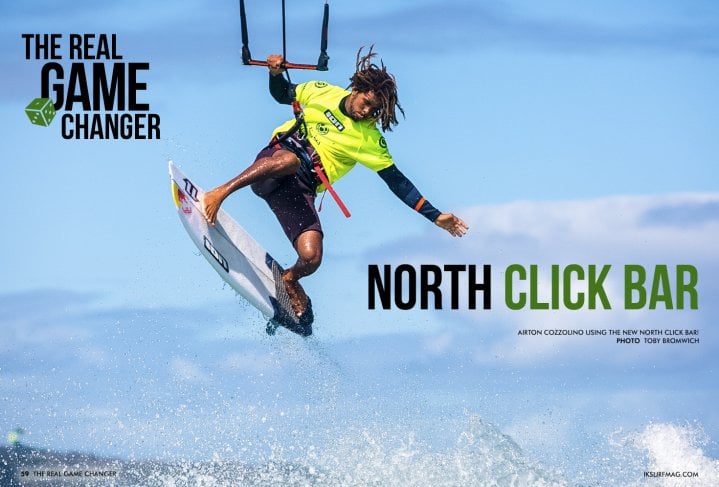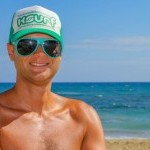
The Real Game Changer - North
Issue 59 / Thu 13th Oct, 2016
Rear line depower is the future, we’ve tasted it, and North have made it a reality, no more flapping depower lines, no more hunting for it or trying to grab it in a gust, just pure control at the tips of your fingers! What do you think of the concept?
The new North Click bar has been turning heads on the internet for a month or so now, it has also been turning heads on beaches too. We’ve had one on test for a while and so far we’ve been loving it. Rear line trim systems make a lot of sense, there is less pressure on the rear lines so it is easier to power up and depower. You also don’t have to lean off your edge to reach up for the depower rope and you don’t even have to look at what you are doing as once you are familiar with the system you can find it and adjust it easily. We talked to Philipp Becker from North Kiteboarding about the bar and how it can benefit you, we also added in some of your questions from social media.
You’ve had the best-kept secret in the kite industry for years. I first saw a rear line trim bar in Mauritius about five years ago. How did you manage to keep it a secret and were there many leaks?
Philipp Becker: Five years is a bit early as we only started working on our rear line trim system about three years ago, we realised that the concept was great, and the prototypes were working well already. The real challenge was how to get it into serial production without any mistakes. We were estimating to sell approximately 10.000 pieces in the first year, so there was no room for teething problems. Luckily everyone involved was stoked on the idea and was focused on making a solid product that would be around for years to come.
Obviously, there were some leaks, you can't avoid it, but just two weeks before we launched our campaign one of our competitors started with the #Gamechanger. So now there are two Gamechangers, but the proof is always in the pudding. All I can say is get both products in your hands, and it will quickly become clear who is the real Gamechanger.
There have been many comments saying that it won’t work, that it will fill with sand and corrode etc. How long did you test the final production versions for, and how long was the development in total?
In total, the development ran for three years. We had planned for it to be a little shorter but we wanted to be 100% sure that everything was working smoothly. The very final version was tested for over a year, and there were a hundred test bars being put through their paces across the globe. Everyone from our regular customers, developers, office crew, ambassadors, not to mention our huge team of world class riders tested the products in every condition and destination imaginable. There's no doubt that the final version has been put to the test.
It's always interesting how people know so much about a product they never had in their hands, be it the new iPhone, the new Audi A6, even the new Ducati. My recommendation is to go to a North Kiteboarding demo event, test the bar, see if you like it and then decide. At the end of the day, if something were to go wrong we have our warranty terms as well as the +6 registration scheme that gives and additional six months. It's all covered. I've been using one of the early prototypes for nearly a year now. I've never rinsed it with fresh water, never taken good care of it, I've tried to abuse it as much as possible wherever I go, and I still haven’t had any problems.
What was the biggest challenge with the development of this product, aside from keeping it under wraps?
The biggest challenge was to get the idea from the prototype stage into mass production. It´s easy to build one prototype, but to have a couple of thousand pieces produced with the same quality is a challenge.
How many people worked on it at North Kiteboarding, and did you have any outside help aside from the original patent designs?
The original idea came from Jerome Bonieux. He and one of our product designers AurelienMierswa were the main people pushing the project to where it is today. I think we can all agree that it is a real innovation for our sport. During the testing phase everybody within the NKB team was involved, making it the biggest panel of critics and honest testers. This was crucial for finding solutions to all problems encountered asap.
Do you see the Click Bar replacing all bars in the future? Do you still have the Trust Bar and Wakestyle Bar available at the moment? Is it suitable for everyone?
The Click Bar definitely has the potential to do so, but it is also at a higher price point from other bars which is often an influencing factor. That said, the Click Bar allows you to use it with 22m and 24m – due to extensions - and you can fly nearly any kite on the market due to the V adjustment and additional pigtails. So for a bit more money, you can actually save money by not having a second bar.
For the first year, we wanted to carry over the Trust Bar for our loyal customers, as well as the Wakestyle Bar for the team and dedicated wakestylers. We were 100% sure that the Click Bar would be brilliant for freeriders in terms of comfort, safety and ease of use. For wave riders, it delivers much more freedom and options for powering and depowering. It's like shifting gears on your bike. We were surprised to see this translate across to our park riders like Craig Cunningham, who loves the bar for depowering the kite just before he hits a feature and knowing exactly the amount of clicks he had to do each time to suit the conditions; something impossible to do with a dangling rope adjuster. So yes, I do think it´s suitable for everybody.
Photoshoots and contests are always a good indicator as well. I just got back from a wave shoot and the GKA contest in Mauritius where we gave the riders the option to choose between the Trust Bar and the Click Bar. Yes, you guessed, they all chose the Click Bar. Nevertheless, the Trust Bar is still state-of-the-art in terms of safety and reliability when compared to many competitors.
It’s been designed to run on any kite, with lots of tuning options to ensure it works across a broad range of kites from many brands. Do you see a future where we buy a kite from one brand, then a bar from another, according to our preference of the systems in use?
For now, I predict that you'll buy a kite and then a bar with the most comfort and safety for that kite. Unfortunately, there are still some bars out there for the same amount of money with inadequate safety systems. Surprisingly enough, the V-adjustment and the quality of the lines of the Click Bar further enhances the feel of the kite.
What are the advantages for the riders with the Click Bar, and are there any disadvantages?
The main advantages are the super precise adjustment system, the automatic untwisting feature, the accessibility, the comfort and the freedom this bar delivers. For wakestylers/freestylers I can see that the length of the bar is not ideal for passes, however, for freeriders and in the waves it´s a whole new sensation of kiteboarding.
What is the warranty on the product like?
As I mentioned before the Click Bar carries the warranty terms of your country, plus an additional six months if you register your product with our +6 scheme.
Why is it so expensive and what makes kite bars cost so much money?
Is it actually that expensive? Compared to your mountain bike, your electric skateboard or anything that delivers you guaranteed fun? It might be more expensive than other North Kiteboarding bars but equal in price to existing bars on the market, which don't have the new brilliant concept.
With this Click Bar, you´ll feel the innovation in kitesurfing, you´ll get the option for 22m and 24m lines, it can be upgraded to 5 lines, it has several new functions, most of all it´s safe. You can use all your old kites with it no matter the brand, it comes with the newest safest and most reliable Iron Heart, and without a doubt, it’s worth every penny!
Videos
By Rou Chater
Rou has been kiting since the sports inception and has been working as an editor and tester for magazines since 2004. He started IKSURFMAG with his brother in 2006 and has tested hundreds of different kites and travelled all over the world to kitesurf. He's a walking encyclopedia of all things kite and is just as passionate about the sport today as he was when he first started!
















